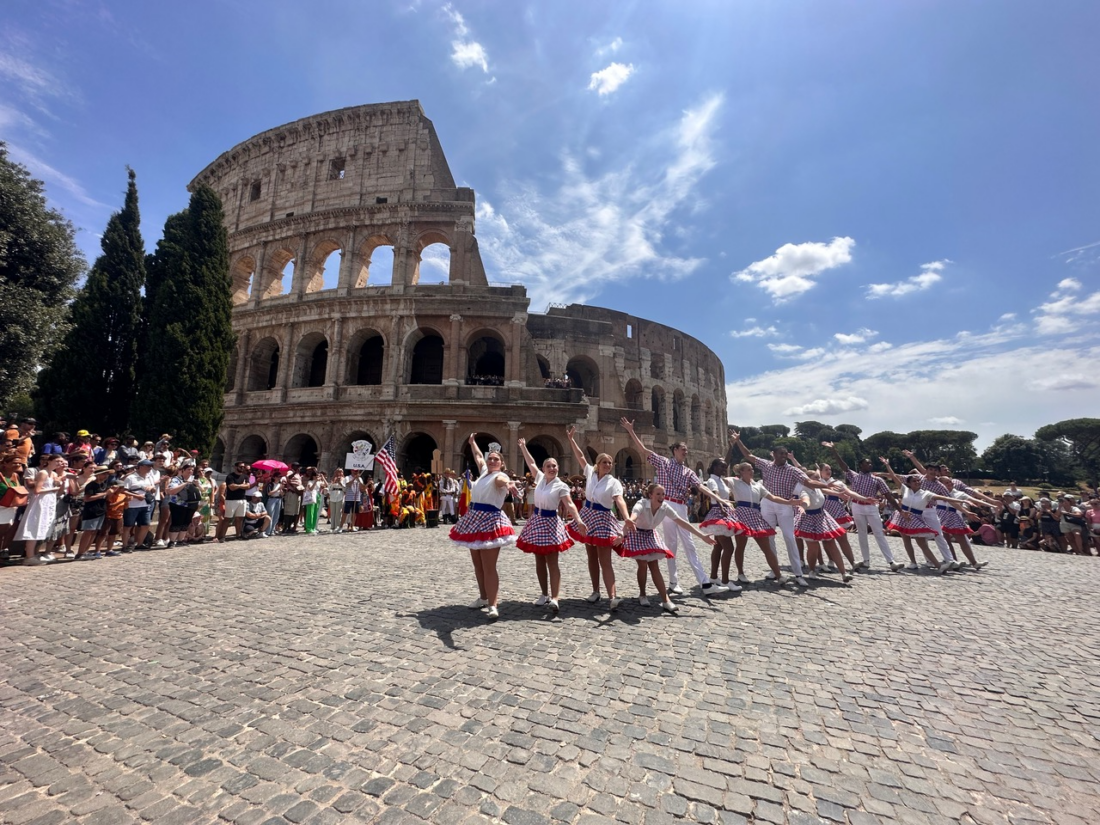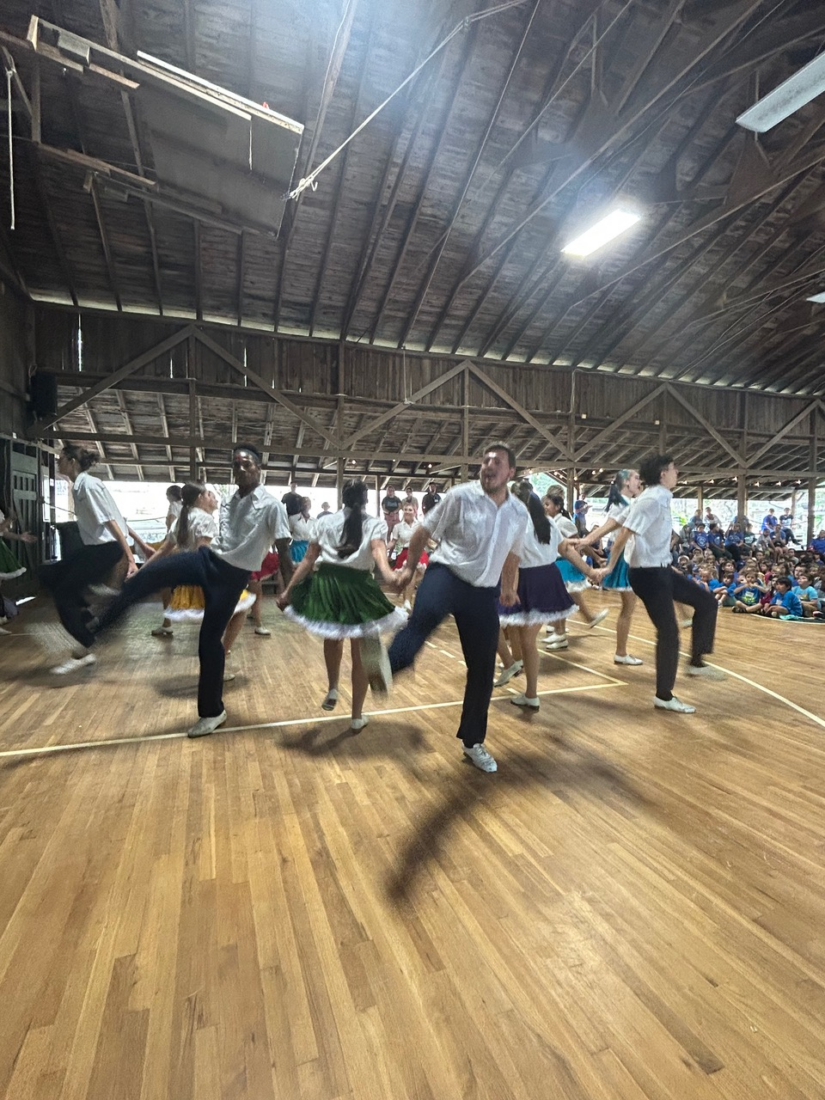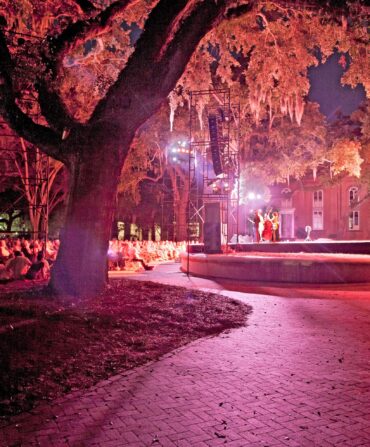On any given weeknight, the campus of Mars Hill University buzzes with life. Down on Athletic Street, the lacrosse team might be practicing on the stadium turf while fans stream into the adjacent Chambers Gymnasium for a basketball double-header. Whistles emanate from the former, muffled warm-up music from the latter. Students whiz about on skateboards and in packed cars.

But climb the hill, past the library and into the heart of the campus in the mountains of Western North Carolina, and the game-day noise will give way to the sound of another team in preparation. Coming from the old McConnell gymnasium, it sounds like a fast-approaching train.
TACK tick-a-tack tick-a-tack tick-a-tack.
Descend the steps from the ground floor into the McConnell basement, and the sound grows louder. A drizzle swells into a downpour, a whimper into a howl. Open the white, wooden door marked 103 and the vibration swallows you. Twenty-three sets of legs, black and white, male and female, locked in unison:
CLACK-CLACK-CLACK.
These are the Bailey Mountain Cloggers, the nation’s finest collegiate clogging team.
For nearly fifty years, the Bailey Mountain Cloggers have served as a conduit between an old Appalachian art form and the ever-changing tastes of youth. The program teaches century-old steps—routines that, like much of what is considered Appalachian, draw heavily from Scotch-Irish and African traditions—while giving students space to create contemporary versions. It keeps the past alive by inviting the future in.
The result is a wide-ranging dominance. The Bailey Mountain Cloggers have brought thirty-one national championships to this quiet Baptist college. The team has commanded spotlights as bright as those of the Kennedy Center and Broadway.
In the process, the program has extended the lifespan of traditional clogging, taking primarily modern dancers, feeding them through a four-year system soaked with reverence for the past, and popping them out on the other side to spread the gospel of Country Hoedown, Smooth Mountain Square Dance, and Traditional Line, or “Trad Line.”
Yet that same commitment to the old is partly to blame for a decline in the team’s numbers—from a peak of fifty dancers in the early aughts to twenty-three in 2023—as general preference shifts towards the contemporary. The leanness of the roster has only brought these cloggers closer together. Every step matters. Without Bailey Mountain, one of the only collegiate programs of its kind in the country, the historical elements of the dance could very well fade from popular consciousness.
Richard Dillingham is a slender man with glasses, wispy hair, and a sharp memory despite his eighty-five years. A known presence on campus and in the town of Mars Hill, he is the type of person who can’t make a run to the local coffee shop without bumping into a clogging alum or fan.
Dillingham had no real dance experience when he was asked to take over as the team’s director in 1988. Until that point, Bailey Mountain had always been student-led and focused solely on contemporary dancing. As the group’s new leader, he made the kids a deal. If they could get down with the old, he told them, he’d buy into the new.
“They didn’t think that was too hot,” he remembers. “They were interested in rock and roll.”
But Dillingham persisted, and despite their initial reluctance, his students came to love traditional clogging, and the team’s duality was born.

Each successive director of Bailey Mountain has made their own mark. Jay Ledford, who clogged under Dillingham before becoming the director himself in 1996, developed the team’s theatrical style, emphasizing flow and rhythm over precision. Under Ledford, the team earned invitations to perform on Broadway, at the Kennedy Center, at the Atlanta Olympics, and on the BBC in Ireland.
The sense of showmanship pervaded even their regular gigs, bringing big-city spectacle to the sleepy mountain town. Current director Danielle Plimpton clogged under Ledford. “When I danced for [Ledford] and did his choreography, I felt like I was on Broadway,” she says.
Plimpton took over the program in 2006. Her strongest asset, according to her dancers, is the creativity she brings to her choreography, costume designs, and the themed spring concerts she creates from scratch each year. Now she finds herself wielding that creativity to keep the roster size above the panic line.
The price tag of attending Mars Hill University ($47,498 per year as of 2023) remains the program’s biggest recruitment hurdle. The clogging team gets $30,000 to allocate for scholarships. Many student cloggers hold off-campus jobs and serve on the cheer or dance teams, both of which Plimpton also coaches, for extra scholarship money. Yet Plimpton always seems to dig up more funds for dancers in need. Clogger Keyshawn Sanders says he has considered leaving the university on multiple occasions because of costs. Each time, Plimpton has found a way to keep him on campus. “She would always find a way to get me another scholarship or raise my scholarship,” he says. “She just does a lot.”
Sometimes that even includes suiting up and taking the stage.
Located just off of I-26 on the outskirts of Columbia, South Carolina, the Jamil Shrine Temple is a windowless, bunker-like room roughly the size of a football field. Every winter, teams of cloggers from across multiple states gather here for the Capital City Clogging Classic. They rehearse in uniform packs as crock pots of chili and nacho cheese simmer nearby.
Few clogging programs are affiliated with universities. North Carolina State has one geared more toward performance than competition, and Brigham Young University’s ensemble explores a broader variety of folk dancing. The Bailey Mountain Cloggers have faced off against NC State before, but usually it competes against studios and clubs rather than schools.

Such is the case at the 2023 Capital City Clogging Classic—a fact that doesn’t make the event any less exciting. Following a 4 a.m. wakeup and a three-hour van ride, Bailey Mountain will take the stage at 8:30 a.m. for its first dance of the day, Country Hoedown. Powered by caffeine and doughnuts, the team is synced, dialed, ready.
Tinka-tink Tinka-tink Tinka-tink.
Every dance requires an outfit change and group warm-up, leaving little time between the end of one and the preparation for the next. For upperclassmen like Sanders, there is even less time to rest. He is scheduled for twelve of the thirteen team routines in addition to a solo.
Sanders grew up in a football family in Union, South Carolina. At north of six feet tall with a muscle-bound physique, he looked to be next in line for gridiron stardom. But he liked to dance.
His best friend, Tykasia Davis, urged him to join their high school cheer team as its only male member. He was an immediate star, delighting the student section with on-command backflips and toe-touches. When Davis decided to attend Mars Hill University to dance, she again convinced Sanders to join her. He arrived on campus as a cheerleader, but Plimpton saw potential and invited him to join the cloggers. By sophomore year, he had choreographed his own solo routine. In October 2021, he won a national championship with it. In 2022 and 2023, he would repeat that victory.
As the song begins for his solo in Columbia, he springs into a blend of clog steps, cheerleading motions, and hip-hop moves. He opens with a full split and finishes by falling backward onto the stage as a rock star might into an audience. The room explodes. His teammates, standing just off the stage, scream.

“Keyshawn, how long have you been clogging?” the PA announcer asks over the microphone.
“Three years,” he shouts.
“THREE YEARS!?”
Chest huffing and hands on his hips, he makes his way to the back of the room for another outfit change and a snack.
By 5:30 p.m., many hours, miles, and dances into their day, director Plimpton, Sanders, and the rest of the team make their way back toward the stage. Although she started the day in running tights and a T-shirt, Plimpton is now wearing a long-sleeved blue top and black skirt. Because her team is small, she is filling in for the Open Precision routine.
Plimpton calls a huddle; team members pack in close, shutting everything out behind them.
“I don’t think y’all understand how much you mean to me…1-2-3!”
“BMC!”
It’s a beautiful dance, a championship dance, and a number of Bailey Mountain alums, including the event’s organizer and several judges, are there to witness it. Everywhere the Bailey Mountain Cloggers go, they are greeted by dancers of the past—in the local coffee shops and in the crowd of a performance, but also in the university archives, where boxes brim with newspaper clippings, notes, promotional flyers, letters, and photos.
There are photos of past teams posing in front of a “Welcome to Florida” sign, walking the streets of Europe, and playing cards. Shots of the team stopping for McDonald’s and sharing Thanksgiving dinner. They show outfits and hairstyles representing every decade. One day soon, the music will stop for the faces that are on stage today, but their memories and accomplishments will live on, a past version of themselves preserved in dance.








